Unit 6 When was it invented?Section B 1a-1e 课件(共22张PPT) 人教版英语九年级全册
文档属性
| 名称 | Unit 6 When was it invented?Section B 1a-1e 课件(共22张PPT) 人教版英语九年级全册 | 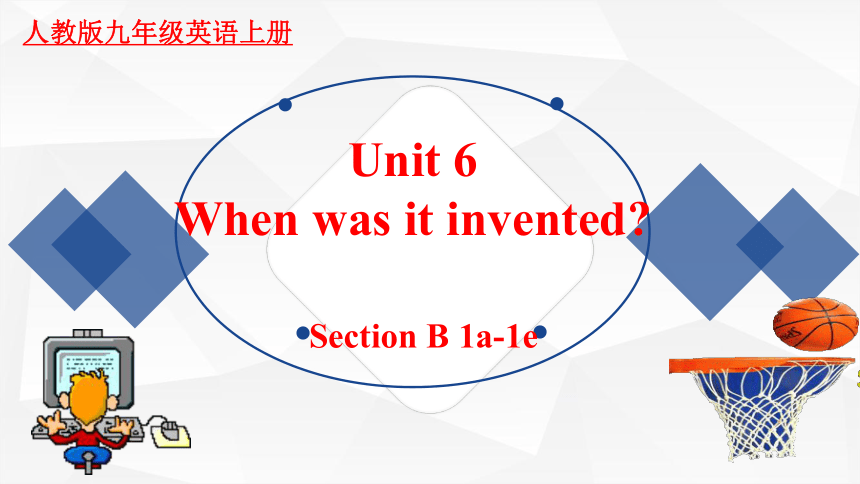 | |
| 格式 | pptx | ||
| 文件大小 | 8.9MB | ||
| 资源类型 | 教案 | ||
| 版本资源 | 人教新目标(Go for it)版 | ||
| 科目 | 英语 | ||
| 更新时间 | 2024-09-16 15:57:40 | ||
图片预览

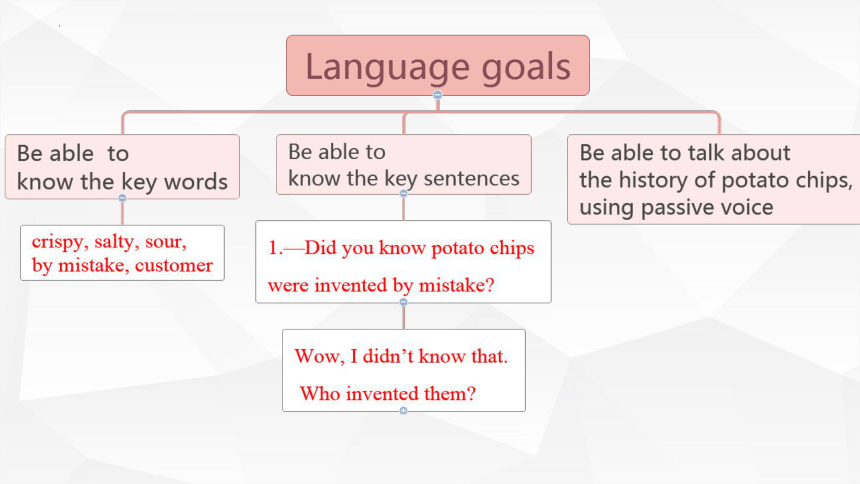

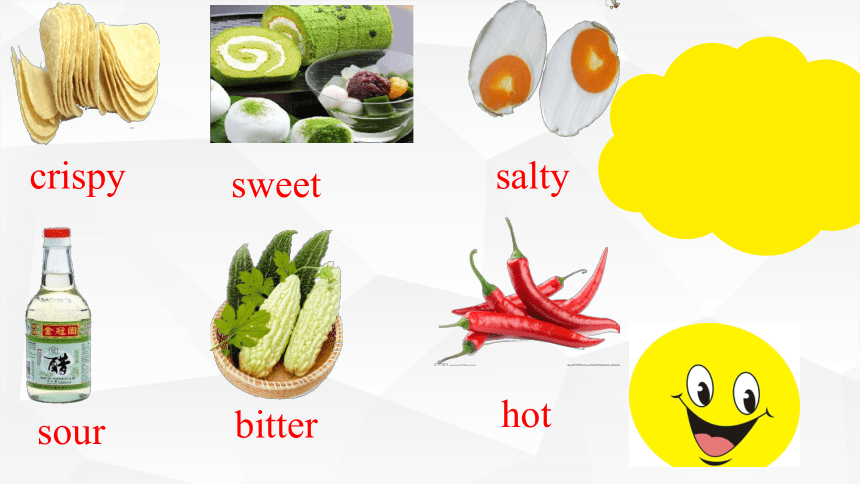
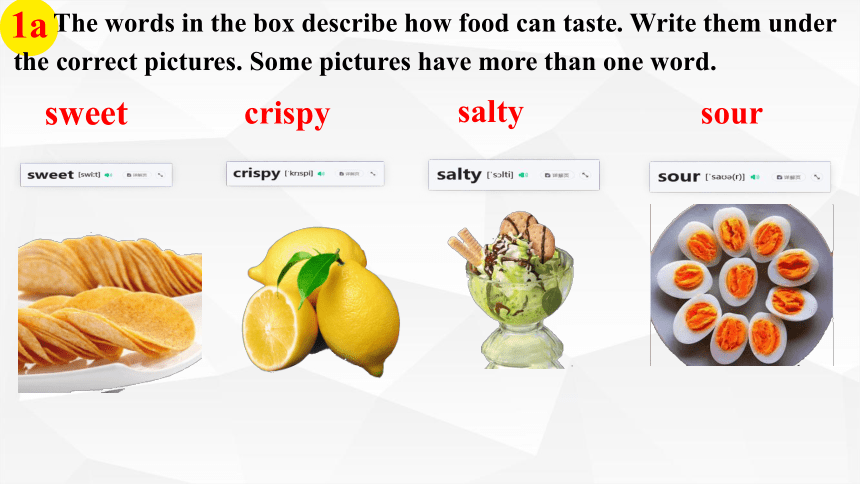
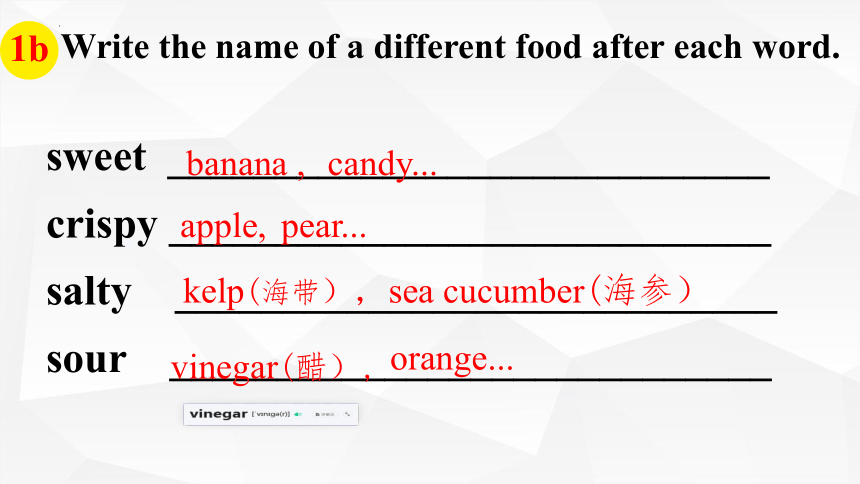
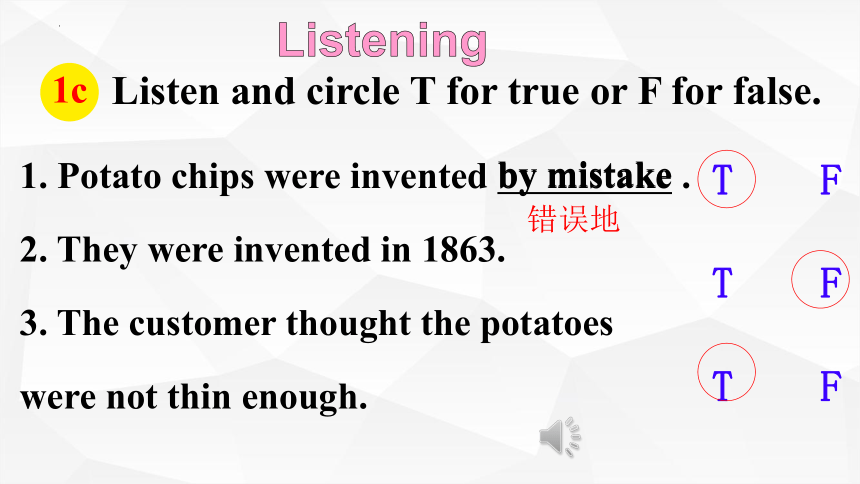
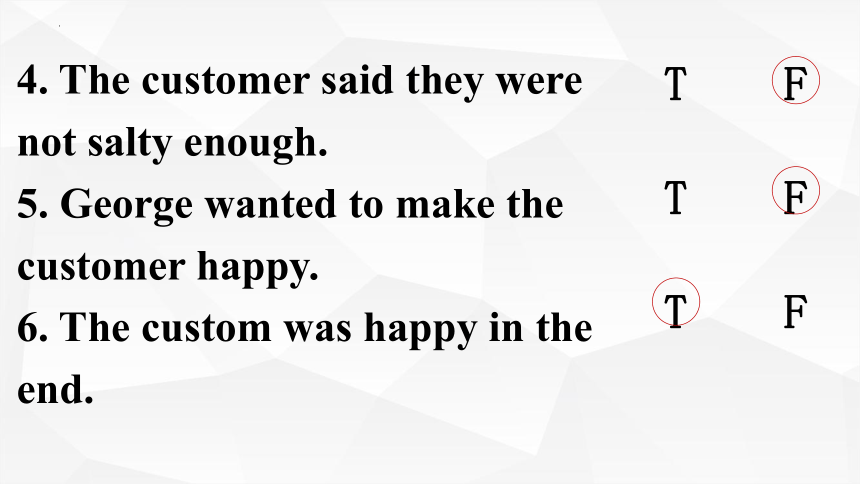
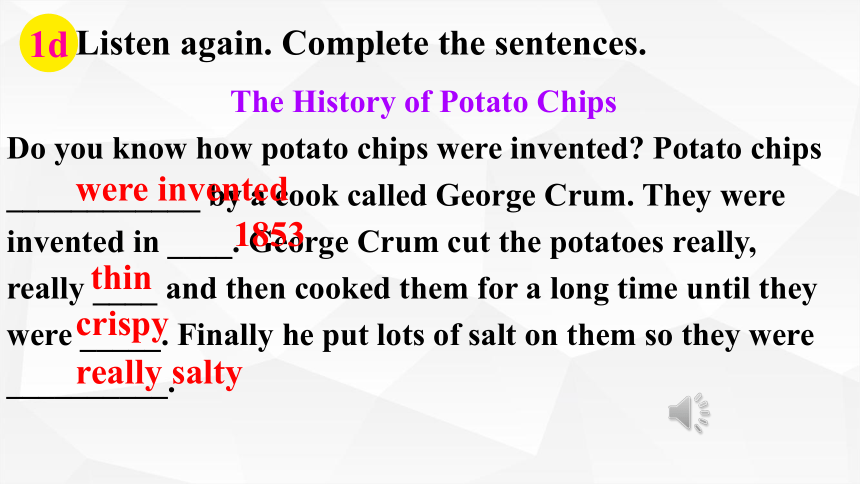
文档简介
(共22张PPT)
Unit 6
When was it invented
Section B 1a-1e
人教版九年级英语上册
Do you like ice cream
What do you think of them
Sweet
cool
delicious
crispy
sweet
salty
sour
bitter
hot
How do they taste
The words in the box describe how food can taste. Write them under the correct pictures. Some pictures have more than one word.
sweet
crispy
salty
sour
1a
Write the name of a different food after each word.
1b
sweet ____________________________
crispy ____________________________
salty ____________________________
sour ____________________________
banana ,
apple,
pear...
kelp(海带),
sea cucumber(海参)
vinegar(醋),
orange...
candy...
Listening
Listen and circle T for true or F for false.
1c
1. Potato chips were invented by mistake .
2. They were invented in 1863.
3. The customer thought the potatoes
were not thin enough.
T F
T F
T F
by mistake
错误地
4. The customer said they were not salty enough.
5. George wanted to make the customer happy.
6. The custom was happy in the end.
T F
T F
T F
Listen again. Complete the sentences.
The History of Potato Chips
Do you know how potato chips were invented Potato chips ____________ by a cook called George Crum. They were invented in ____. George Crum cut the potatoes really, really ____ and then cooked them for a long time until they were _____. Finally he put lots of salt on them so they were __________.
were invented
1853
thin
crispy
really salty
1d
Pair work
Make a conversation about the invention of potato chips. Use the information in 1c and 1d.
Did you know potato chips were invented by mistake
Wow, I didn’t know that. ...
Ask and answer one of the following questions
1.Who invented them
2.When were they invented
Ask and answer the above two questions
Ask and answer the above two questions , then ask and answer "How were they invented
Show time!
Summary
1.Key vocabulary:
crispy, salty, sour, by mistake, customer
—Did you know potato chips were invented by mistake
—Wow, I didn’t know that. Who invented them
2.
The History of Potato Chips
when, who, how...
Homework
1. Try to remember the key words and sentences.
2. Try to repeat the history of potato chips.
Are you ready to have a try
Thank you for your listening!
Explanation of Teaching
教材分析(material analysis)
教学目标(aims)
教法(methods)
学法(methods)
教学环节(procedures)
Unit 6
When was it invented
Section B 1a-1e
一、教材分析
今天我的课堂阐述的内容是人教版《新目标英语》九年级全一册Unit6When was it invented (1a-1e).
本单元的核心话题是谈论发明,主要介绍了古今中外的一些重要发明。本课的教学内容与学生的实际生活密切相关,容易引起学生兴趣。本节课内容中的被动语态,是中考的一个重点,也是难点。学生必须通过学习能够正确地运用被动语态,对发明作出自己的反馈和评价,同时能够详细的用所学句型去介绍自己喜欢的或熟悉的发明物。
在新课程理念的指导下,结合本课的实际情况,我制定了以下核心素养:
(1)知识与技能目标通过本节课的学习,学生能够运用相关词汇和句型谈论发明物。并能进一步了解被动语态,并能模仿运用。
(2)过程与方法目标
通过情景对话、小组竞赛、游戏等活动培养学生的观察力和表达能力。通过听力及上下文的学习提高学生的听力技巧和逻辑思维能力。
(3)情感态度价值观目标
通过谈土豆条的发明让学生了解发明都偶然中的必然。
二、教学目标
三、教法
英语学习的目的重在更好地运用语言于实际的交流之中,单调地重复课文内容或机械地练习吸引不了我们的学生。本着启发性教学原则,我在课堂上主要采用合作探究法、情景交际法、任务教学法等,尽量创设真实的语言交流情景,进行师生互动、生生互动,分组合作,倡导学生主动参与、勇于开口、大胆表演,以求更好地突破教学重难点,完成教学目标。
四、学法
英语学习的目的重在更好地运用语言于实际的交流之中,单调地重复课文内容或机械地练习吸引不了我们的学生。本着启发性,突驻体性的教学原则,我采用合作探究法、情景交际法、直观教学法,任务教学法等,在课堂上尽量创设真实的语言交流情景,进行师生互动、生生互动,分组合作,倡导学生主动参与、勇于开口、大胆表演,以求更好地突破教学重难点,完成教学目标。
五、教学环节(6)
Lead-in
Presentation
(1a-1b)
Summary
Paiwork
Listening
Homework
Unit 6
When was it invented
Section B 1a-1e
人教版九年级英语上册
Do you like ice cream
What do you think of them
Sweet
cool
delicious
crispy
sweet
salty
sour
bitter
hot
How do they taste
The words in the box describe how food can taste. Write them under the correct pictures. Some pictures have more than one word.
sweet
crispy
salty
sour
1a
Write the name of a different food after each word.
1b
sweet ____________________________
crispy ____________________________
salty ____________________________
sour ____________________________
banana ,
apple,
pear...
kelp(海带),
sea cucumber(海参)
vinegar(醋),
orange...
candy...
Listening
Listen and circle T for true or F for false.
1c
1. Potato chips were invented by mistake .
2. They were invented in 1863.
3. The customer thought the potatoes
were not thin enough.
T F
T F
T F
by mistake
错误地
4. The customer said they were not salty enough.
5. George wanted to make the customer happy.
6. The custom was happy in the end.
T F
T F
T F
Listen again. Complete the sentences.
The History of Potato Chips
Do you know how potato chips were invented Potato chips ____________ by a cook called George Crum. They were invented in ____. George Crum cut the potatoes really, really ____ and then cooked them for a long time until they were _____. Finally he put lots of salt on them so they were __________.
were invented
1853
thin
crispy
really salty
1d
Pair work
Make a conversation about the invention of potato chips. Use the information in 1c and 1d.
Did you know potato chips were invented by mistake
Wow, I didn’t know that. ...
Ask and answer one of the following questions
1.Who invented them
2.When were they invented
Ask and answer the above two questions
Ask and answer the above two questions , then ask and answer "How were they invented
Show time!
Summary
1.Key vocabulary:
crispy, salty, sour, by mistake, customer
—Did you know potato chips were invented by mistake
—Wow, I didn’t know that. Who invented them
2.
The History of Potato Chips
when, who, how...
Homework
1. Try to remember the key words and sentences.
2. Try to repeat the history of potato chips.
Are you ready to have a try
Thank you for your listening!
Explanation of Teaching
教材分析(material analysis)
教学目标(aims)
教法(methods)
学法(methods)
教学环节(procedures)
Unit 6
When was it invented
Section B 1a-1e
一、教材分析
今天我的课堂阐述的内容是人教版《新目标英语》九年级全一册Unit6When was it invented (1a-1e).
本单元的核心话题是谈论发明,主要介绍了古今中外的一些重要发明。本课的教学内容与学生的实际生活密切相关,容易引起学生兴趣。本节课内容中的被动语态,是中考的一个重点,也是难点。学生必须通过学习能够正确地运用被动语态,对发明作出自己的反馈和评价,同时能够详细的用所学句型去介绍自己喜欢的或熟悉的发明物。
在新课程理念的指导下,结合本课的实际情况,我制定了以下核心素养:
(1)知识与技能目标通过本节课的学习,学生能够运用相关词汇和句型谈论发明物。并能进一步了解被动语态,并能模仿运用。
(2)过程与方法目标
通过情景对话、小组竞赛、游戏等活动培养学生的观察力和表达能力。通过听力及上下文的学习提高学生的听力技巧和逻辑思维能力。
(3)情感态度价值观目标
通过谈土豆条的发明让学生了解发明都偶然中的必然。
二、教学目标
三、教法
英语学习的目的重在更好地运用语言于实际的交流之中,单调地重复课文内容或机械地练习吸引不了我们的学生。本着启发性教学原则,我在课堂上主要采用合作探究法、情景交际法、任务教学法等,尽量创设真实的语言交流情景,进行师生互动、生生互动,分组合作,倡导学生主动参与、勇于开口、大胆表演,以求更好地突破教学重难点,完成教学目标。
四、学法
英语学习的目的重在更好地运用语言于实际的交流之中,单调地重复课文内容或机械地练习吸引不了我们的学生。本着启发性,突驻体性的教学原则,我采用合作探究法、情景交际法、直观教学法,任务教学法等,在课堂上尽量创设真实的语言交流情景,进行师生互动、生生互动,分组合作,倡导学生主动参与、勇于开口、大胆表演,以求更好地突破教学重难点,完成教学目标。
五、教学环节(6)
Lead-in
Presentation
(1a-1b)
Summary
Paiwork
Listening
Homework
同课章节目录
- Unit 1 How can we become good learners.
- Section A
- Section B
- Unit 2 I think that mooncakes are delicious!
- Section A
- Section B
- Unit 3 Could you please tell me where the restroom
- Section A
- Section B
- Unit 4 I used to be afraid of the dark.
- Section A
- Section B
- Unit 5 What are the shirts made of?
- Section A
- Section B
- Review of Units 1-5
- Unit 6 When was it invented?
- Section A
- Section B
- Unit 7 Teenagers should be allowed to choose their
- Section A
- Section B
- Unit 8 It must belong to Carla.
- Section A
- Section B
- Unit 9 I like music that I can dance to.
- Section A
- Section B
- Unit 10 You're supposed to shake hands.
- Section A
- Section B
- Review of Units 6-10
- Unit 11 Sad movies make me cry.
- Section A
- Section B
- Unit 12 Life is full of the unexpected
- Section A
- Section B
- Unit 13 We're trying to save the earth!
- Section A
- Section B
- Unit 14 I remember meeting all of you in Grade 7.
- Section A
- Section B
- Review of Units 11-14
